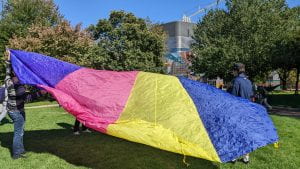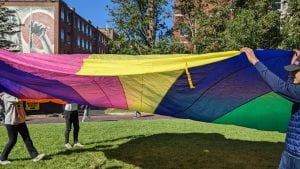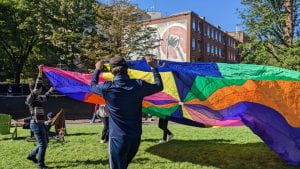Score:
Float a pretty parachute with some friends and a chair,
String them along in public with no shame but much care.
Artist’s Statement:
Beach Scene: A Performance and a Piece. This score was inspired by Allan Kaprow’s Happenings. When reading about his 18 Happenings in 6 Parts (1968), I was intrigued by the idea of blurring mundane life activities and art. In Kaprow’s piece, audience members had to switch seats to move on to the next set of Happenings that were occurring in trios. The Happenings were not linked, intriguing but also of familiar actions, engaging the audience in a way unlike anything else at the time. In class, when we went out into Centennial Commons and staged our own Happening, I loved watching the class create goals for themselves and then try to enact them with the varied paraphernalia around. I was a part of a Happening where we tried to get a parachute to fly using string and help from a chair. In doing so, we created a performance for the other students on the quad and even got a stranger to take a picture of us with a drone. The barrier between us as artists and our audience was broken in a beautiful way that moved me. The audience couldn’t tell if it was a performance or if we were just playing for fun, blurring the line between daily activities and art, much like Kaprow did.
I wanted to capture this experience in a score, but I didn’t want all who partook in enacting the score to end up with the exact same result. John Cage demonstrated how introducing elements of randomness in an art piece allows for unexpected yet interesting results that I believed would foster a sense of ownership and uniqueness to the Happenings players would create using my score. It also allows for the score to be “replayed” and a different result to arise. As such, I drew inspiration from Yoko Ono’s Grapefruit in structuring a score that was simple and left much room for interpretation so that the art created was truly unique every time.
The title includes “Beach Scene” so as to get artists to think about the beach and potentially performing it there, although the actual location of the performance isn’t too important. Beaches do, however, have lots of wind and water, both of which can be used for the ‘floating’ exercise mentioned in the score. I implored players to ‘float’ (up to their interpretation) a ‘pretty parachute’ (also up to their interpretation) with friends a a chair. The number of friends is left unknown as is how the chair is used. In getting players to reach a goal that is somewhat confusing or non-sensical, they have to be creative and end up making something unique. The phrase “String them along in public with no shame but much care.” not only rhymes with the line above to encourage non-literal thinking, but also uses string as a verb, alluding to our use of string in the original Happening. I also instruct that the Happening be enacted in public with no shame so that players don’t try to hide. This inadvertently include their audience in the performance and introduces an element of randomness. It’s likely that someone outside of the original group of friends will interact with the Happening or at least watch and comment from afar. Lastly, I implore the players to float the parachute with much care, hoping that they take the time to consider the affordances of the parachute and the way they are framed during the performance.
When I playtested this score in class, the results were wonderful. The playtesters ‘strung along’ a passerby who they recognized and got them to sit in a chair that they then engulfed with the parachute. They then tried to get the parachute to float in the wind before running underneath it and trying not to get trapped. The performers made a game, one that was interesting to watch and blurred the line between art and daily play. As such, I think the score was a success!




